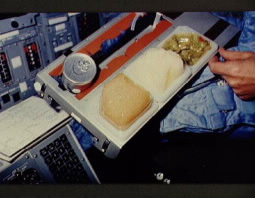EMBARGOED FOR RELEASE | August 28, 2011
Filling the pantry for the first voyages to the Red Planet
Note to journalists: Please report that this research was presented at a meeting of the American Chemical Society.
DENVER, Aug. 28, 2011 — A green thumb and a little flair as a gourmet chef may be among the key skills for the first men and women who travel to the Red Planet later this century, according to a scientist who reported here today on preparations for the first manned missions to Mars.
Speaking at the 242nd National Meeting & Exposition of the American Chemical Society (ACS), Maya R. Cooper said that provisioning the astronauts with food stands as one of the greatest challenges in scripting the first manned mission to Mars. ACS, the world largest scientific society, opened the meeting today at the Colorado Convention Center and downtown hotels. With more than 7,500 reports on new advances in science and some 9,500 scientists and others expected in attendance, it will be one of 2011’s largest scientific gatherings.
Cooper explained that the challenges of provisioning space vehicles and Martian surface bases begin with tangible factors, such weight and nutrition, and encompass psychological nuances, such as providing a varied, tasty menu that wards off boredom. The solutions envisioned now include requiring astronauts to grow some of their own food and engage in much more food preparation than their counterparts on the International Space Station.
Media Contact
During the meeting, Aug. 25-Sept. 1, the contacts can be reached at: 303-228-8532
Michael Bernstein
202-872-6042
m_bernstein@acs.org
Michael Woods
202-872-6293
m_woods@acs.org
The major challenge is to balance weight, food acceptability and resource utilization, Cooper explained. She is a senior research scientist at the NASA Johnson Space Center in the Space Food Systems Laboratory in Houston, Texas. For flights on the space shuttles and the International Space Station, astronauts get 3.8 pounds of food per day. For a 5-year round-trip mission to Mars, that would mean almost 7,000 pounds of food per person.
“That’s a clear impediment to a lot of mission scenarios,” Cooper said. “We need new approaches. Right now, we are looking at the possibility of implementing a bioregenerative system that would involve growing crops in space and possibly shipping some bulk commodities to a Mars habitat as well. This scenario involves much more food processing and meal preparation than the current food system developed for the space shuttles and the International Space Station.”
Bioregenerative systems involve growing plants that multi-task. They would supply food, of course. But just as plants do in natural environments on Earth, those growing in bioregenerative systems also would release oxygen for the astronauts to breathe, purify the air by removing the carbon dioxide that crews exhale and even purify water.
Ideally, these plants would have few inedible parts, would grow well with minimal tending and would not take up much room. Ten crops that fit those requirements have emerged as prime candidates for the Mars mission’s kitchen garden. They are lettuce, spinach, carrots, tomatoes, green onions, radishes, bell peppers, strawberries, fresh herbs and cabbages.
Cooper cited another option for these missions, the first of which could launch in the 2030s, according to some forecasts. Shipping bulk commodities to Mars could involve unmanned spacecraft launched a year or two before the astronauts depart to establish stashes of food with long shelf-lives that the crew could use while exploring the Red Planet.
Engaging astronauts in food production and preparation is the latest concept in a 50-year evolution of technology for filling astronauts’ and cosmonauts’ larders, Cooper noted. It began when Yuri Gagarin reportedly munched on patÉ and caviar during that first manned spaceflight in 1961.
Space food has come a long way since the days of freeze-dried food blocks and squeezing gooey foods out of toothpaste tubes that astronauts ate in the earliest days of space flight. By the late 1960s, astronauts for the first time could have hot food and eat their food with a spoon in a special bowl. Other utensils were introduced in the 1970s with Skylab — the U.S.’ first space station. These astronauts could choose from 72 different foods, some of which were stored in an on-board refrigerator or freezer — a first for space cuisine. In recent years, space shuttle astronauts could drink a coffee with their scrambled eggs for breakfast, snack on chocolates or a brownie and choose from chicken al a King, mushroom soup or rice pilaf among other foods for lunch and dinner — just like on Earth. These prepackaged foods take only a few minutes and little effort to prepare.
“The NASA Advanced Food Technology project is currently working to address the issues of food variety, weight, volume, nutrition and trash disposal through research and external academic and commercial collaborations,” Cooper noted.
###

easy as this space shuttle astronaut — they may
have to grow their own food.


